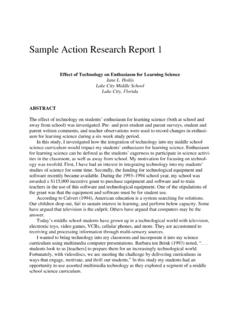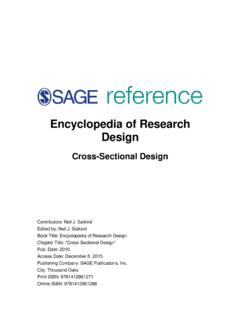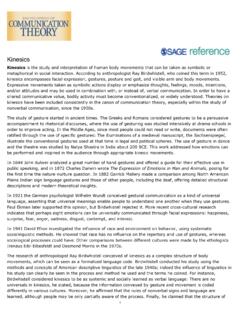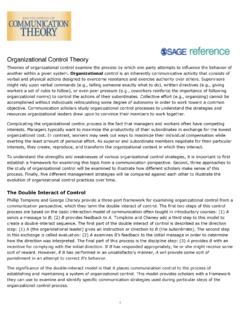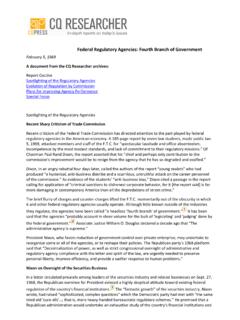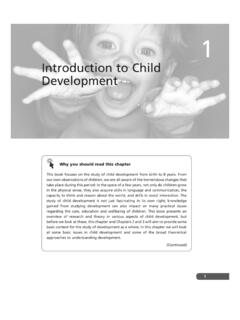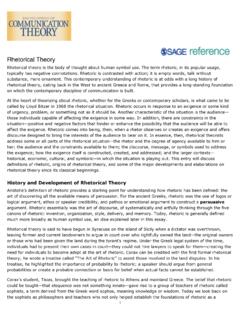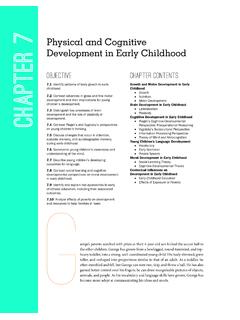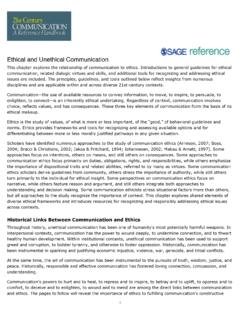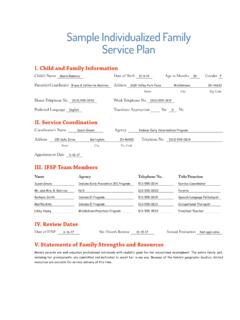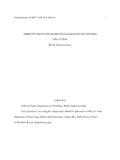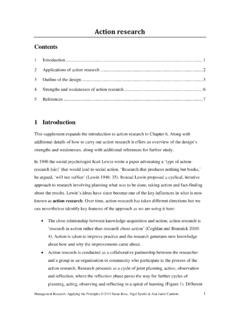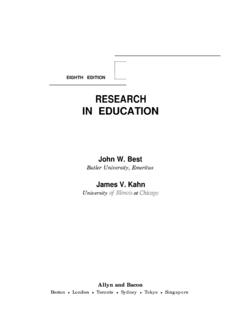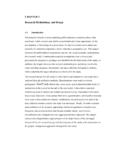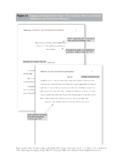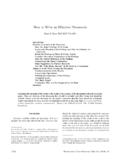Transcription of Sample Action Research Report - SAGE Companion
1 Appendix DSample Action Research ReportToo Loquacious to Be Communicative: In Search of Opportunities for Comprehensible OutputBairbre N Ois nSt. Michael s International SchoolKobe, JapanMarch, 2011 ContentsAcknowledgementsIntroduction What is the background of this Action Research ? Literature Review & Purpose of This Action Research Why is interaction important for ESOL students? Method Who participated in this Action Research ? What did the participants do? How was the data collected? Results and Reflection What was my weakness? What was my Action plan? How effective was my Action plan? What do I want to explore after this Action Research ?
2 Conclusion How do I feel about classroom interaction in the end? My Message to the EARCOS Community How can the results of Action Research impact us? References Appendix Picture cards used in the pretests Picture cards used in the posttests ACKNOWLEDGEMENTSF irst and foremost, I would like to thank the East Asia Regional Council of Schools (EARCOS) for considering our professional growth and taking the initiative in launching the EARCOS Action Research Grant. This is a splendid opportunity not only for each educator to enhance their teaching and their students learning, but also for all educators of EARCOS to be further unified as a learning community.
3 I feel honored to be nominated for one of the first awardees, and I hope that many educators in the community will avail of this wonderful opportunity in the special thanks are due to Mr. Bill Oldread, Assistant Director of EARCOS, whose kind and encouraging words navigated me through the am grateful to Mr. Paul Grisewood, Head of School, who recognized the importance of this Action Research for me and my but by no means least, I would like to thank both my students and their parents, who allowed me to set out this meaningful journey together. I promise to make a continu-ous effort to become a better is the background of this Action Research ?
4 Recently, I had the good fortune to come across an insightful and implicative book entitled Becoming an Emotionally Intelligent Teacher. In the book, Powell and Kusuma-Powell (2010) acutely pointed out that it is not always the case that enhanced knowledge and skills will automatically result in improved classroom instruction and, therefore, improved student learning (p. 38). I felt a strong affinity with the statement, as the underlying reason why I had decided to carry out this Action Research was fully expressed in my capacity as ESOL (English for Speakers of Other Languages) Specialist Teacher, I have been striving to keep abreast with different curriculums, methods, theories, Research findings, activities, textbooks, and so forth, in order to find the best method for my stu-dents.
5 To that end, I have been reading many teacher reference books and academic arti-cles, as well as attending lectures and professional development courses. Such activities surely help me to build a larger teaching practice repertoire. However, it does not mean that I can be more confident in the validity and effectiveness of my teaching in view of each student s English language development, as my students bring diverse English language needs into my ESOL classroom stemmed from the differences in their mother tongue, cul-ture, age, length of time they learn English, and the way their English improves.
6 Ironically, the more I increase my knowledge, the more I come to realize that it is highly unlikely that a single instructional approach or method is likely to be effective for all ELLs [English Language Learners] (Genesee, Lindholm-Leary, Saunders, and Christian, 2006, p. 227).In fact, Kumaravadivelu (2003) articulates that there is no best method out there ready and waiting to be discovered (p. 1) for language teaching, and recommends us to review and improve the fundamental dimensions of our classroom, stating as follows: Creation and utilization of learning opportunities in the classroom are ultimately in the hands of teachers and learners who are engaged in a joint exploration of learning and teaching (p.)
7 47). I decided to scrutinize my classroom interaction with my students through this Action Research , because it is an inescapable and inescapably crucial aspect of classroom life (Allwright, 1984, p. 159) regardless of the content of my lessons, and I felt that enrich-ing this aspect of my classroom was vital for me in order to serve my students various language needs individually, but :Different acronyms are used to refer to non-native speakers of English who receive their education through English, such as EAL (English as an Additional Language), ESL (English as a Second Language), and ESOL, almost interchangeably with each other.
8 I apply ESOL throughout this paper, simply because it is used at my REVIEW & PURPOSE OF THIS Action RESEARCHWhy is interaction important for ESOL students?The importance of conversation and interaction for child language acquisition is described by Hatch (1978) as follows: Language learning evolves out of learning how to carry on con-versations (p. 404). She goes on to say, One learns how to do conversation, one learns how to interact verbally, and out of this interaction syntactic structures are developed (p. 404).In order to engage in conversation and interaction successfully in the classroom, ESOL students need both to understand their teacher and peers, and to make themselves under-stood in English.
9 However, it is only natural that they sometimes fail to achieve it, due to their limited English proficiency. In such cases, it is important for them, with the help of their teacher, to make an effort to turn incomprehensible input and output into comprehensible input (Krashen, 1985) and comprehensible output (Swain, 1985). Long (1996) suggests that it is negotiation for meaning or asking for clarification that enables them to do so, and that their language acquisition is facilitated in the process, because it helps them to provide each other with comprehensible input, to give and gain feedback on contributions and to modify and restructure utterances so that meanings are made clear (Walsh, 2006, p.)
10 22).In particular, the importance of ESOL students opportunity for comprehensible output increases, if we pay attention to the reason why Swain (1985, 1988) drew it. She focused on the speaking and writing underachievement observed among Canadian students who had learnt French through an immersion program, and found out that there was a lack of opportunities for the students to talk, and to be asked to repair their speech in a manner that was grammatically accurate or sociolinguistically appropriate (Swain, 2005, p. 472). Interestingly, they were on a par with their native French-speaking peers both in listen-ing and reading.
